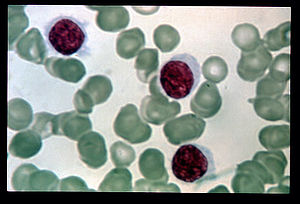Hairy cell leukemia
| Hairy cell leukemia | |
|---|---|
 |
|
| Classification and external resources | |
| Specialty | Hematology and oncology |
| ICD-10 | C91.4 |
| ICD-9-CM | 202.4 |
| ICD-O | M9940/3 |
| DiseasesDB | 5589 |
| MedlinePlus | 000592 |
| eMedicine | med/937 |
| MeSH | D007943 |
Hairy cell leukemia is an uncommon hematological malignancy characterized by an accumulation of abnormal B lymphocytes. It is usually classified as a sub-type of chronic lymphoid leukemia. Hairy cell leukemia makes up approximately 2% of all leukemias, with fewer than 2,000 new cases diagnosed annually in North America and Western Europe combined.
Hairy cell leukemia was originally described as histiocytic leukemia, malignant reticulosis, or lymphoid myelofibrosis in publications dating back to the 1920s. The disease was formally named leukemic reticuloendotheliosis and its characterization significantly advanced by Bertha Bouroncle and colleagues at The Ohio State University College of Medicine in 1958. Its common name, which was coined in 1966, is derived from the "hairy" appearance of the malignant B cells under a microscope.
In hairy cell leukemia, the "hairy cells" (malignant B lymphocytes) accumulate in the bone marrow, interfering with the production of normal white blood cells, red blood cells, and platelets. Consequently, patients may develop infections related to low white blood cell count, anemia and fatigue due to a lack of red blood cells, or easy bleeding due to a low platelet count. Leukemic cells may gather in the spleen and cause it to swell; this can have the side effect of making the person feel full even when he or she has not eaten much.
Hairy cell leukemia is commonly diagnosed after a routine blood count shows unexpectedly low numbers of one or more kinds of normal blood cells, or after unexplained bruises or recurrent infections in an otherwise apparently healthy patient.
Platelet function may be somewhat impaired in HCL patients, although this does not appear to have any significant practical effect. It may result in somewhat more mild bruises than would otherwise be expected for a given platelet count or a mildly increased bleeding time for a minor cut. It is likely the result of producing slightly abnormal platelets in the overstressed bone marrow tissue.
...
Wikipedia
